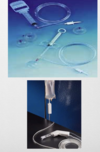Integumentary II Flashcards
(94 cards)
Integumentary II
Odorous wound → (objective?)
Charcoal based, antiseptics
Integumentary II
Undermined / tunneled → (objective?)
lightly pack wound
Integumentary II
Bone/tendon exposure → (objective?)
Protect and keep moist (contact layer)
Integumentary II
Flap/graft exposure → (objective?)
Protect and keep moist (contact layer)
Integumentary II
Necrotic → (objective?)
debride
Integumentary II
granulating/epithelializing → (objective?)
protect and keep moist
Integumentary II
infected wound → (objective?)
antiseptics/antibiotics
Integumentary II
heavily draining wound → (objectives?)
absorb
Integumentary II
sharp debridement
Removal of nonviable tissue only done by PT’s PA’s, some RN’s

Integumentary II
is sharp debridement selective or non-selective form of debridement?
selective
Integumentary II
contraindications to sharp debridement
- Arterial insufficiency ABI <0.5
- Gangrene
- Stable heel ulcers
- Unidentifiable structures
- Terminally ill
Integumentary II
key to comfort in debridement
Know your anatomy
Integumentary II
Autolytic debridement
In biology, autolysis, more commonly known as self-digestion, refers to the destruction of a cell through the action of its own enzymes. It may also refer to the digestion of an enzyme by another molecule of the same enzyme
Integumentary II
surgical debridement is selective or non-selective
non-selective

Integumentary II
Reasons to stop sharps debridement:
- Clinician/patient fatigue
- Bleeding
- Pain
- To viable tissue
- Location of fascial plane
- Location of named structure
- High anxiety level
- Achieved set time limit
Integumentary II
How to stop bleeding:
- Pressure x 10 min
- Elevation
- Calcium alginate
- Xylocaine jelly-vasoconstrictor
- Nitrate sticks-cauterizes tissue
Integumentary II
Wound is lightly scrubbed of surface debris and loose lying slough
mechanical debridement: scrubbing
Integumentary II
is scrubbing a selective or nonselective type of debridement
nonselective
Integumentary II
Wet to dry dressing is a form of debridement.
Is it a selective or non-selective form of debridement?

Non-selective (adheres to both necrotic tissue and viable tissue)
can be painful
Integumentary II
wet to dry dressing is occlusive or non-occlusive?
non-occlusive
“that’s what you want for infected wounds”
Integumentary II
can you use wet to dry dressing in infected wounds?

yes! non-occlusive dressing are for infections
Integumentary II
is Hydrotherapy / Whirlpool selective or non-selective form of debridement?
non-selective
- Softens eschar and slough
- To clean dirt, foreign materials or residues from topical agents in the wound
Integumentary II
Syringe and needle irrigations vs. Pulsatile lavage

Forced Irrigations
Integumentary II
Forced Irrigations are selective or non-selective?

non-selective debridement
- painful, costly, harmful to granulation and epithelial tissue




















